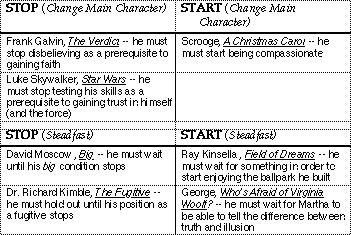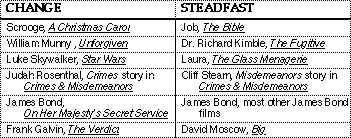The following excerpt is taken from
The Dramatica Class Transcripts
Dramatica: Okay, we move on to Mental Sex…
This question is not about the gender of the main Character. And, it is not about their sexual preferences, AND, it is not about masculine or feminine. It is about problem solving techniques,linear, or holistic. More often than not, if you have a male gender, they are male mental sex, and female gender is female mental sex. Sometimes this is not true. Ripley, in the original Alien, was male mental sex. In fact, the part was written for a man,they just changed the names and gender references, but kept the problem solving techniques intact.
That’s why it is so odd when she goes back for the cat! Not that a man wouldn’t go back, but just that they had not given male reasons to, they just assumed she was a woman, so she would go back,but they had created her as male mental sex.
Now, men or women can easily learn to respond in the opposite sex techniques, but underneath it all is a tendency or bias to adopt either spatial or temporal problem solving techniques.
Clarisse Starling in Silence of the Lambs is another male mental sex character, whereas, Tom Wingo, the Nick Nolte character in Prince of Tides, is Female mental sex. Again, most often, go with what you expect.
PGThomas : Wasn’t Ripey saving the cat meant to build horror suspense, regardless of “mental sex”?
Dramatica : But be aware that it will have an influence on the way your main character goes about solving the problem, not the conclusions they come to.
PGThomas : How could they have established that action for Ripley?
Dramatica : Yes, PG, that is the author’s intent, but if the action is out of place to the established character, even though it may build tension, it rings untrue.
Dan Steele : how do linear/holistic relate to spatial/temporal? not clear.
Dramatica : Well, Dan, female mental sex tries to hold it all together, male tries to pull it all together, female tries to “tune-up” the situation with leverage,male determines steps that lead to the desired outcome. And so on, women look at things holistically, because they think with the time side, men look at things in sequence, because they are using the space side to think with.
PG, all they would have needed to do, is to have Ripley have said to Jonesy, the cat, at some earlier time, that no matter what, she would never leave him.
PGThomas : Gotcha
Dramatica : Then, she would have made a commitment, and that is a male contract.
PGThomas : “Commitment” a male contract? Don’t tell my girlfriend that!
Dan Steele : But there are time sequences ie., do a then b then c; and men do that.
Dramatica : Yes, men stand on space to see time, women stand on time to see space.
William S1 : What?
Dramatica : It all goes back to inside the womb in the 12th to14th week of pregnancy…There is a flush of testosterone or estrogen over the brain of the developing fetus. Testosterone boosts serotonin, the neurotransmitter that is an exciter. Estrogen boosts dopamine, the neurotransmitter that inhibits. This does not affect the body, which is controlled by XX and XY chromosomes, but just the foundation upon which the mind is built.
Dan Steele : hmm, going to run into my resistance on these views of male/female intelligences, but not going to make issue.
PGThomas : Does this flush determine the sex of the baby, or vice versa?
Dan Steele : The stand on space to see time thing versus time to see space is too vague for me without clarification, can’t buy it
Dramatica : One sees easily the arrangement of things, and works to figure out how things are going (paths). That’s seeing logic and figuring the emotions. The other sees emotions clearly, which give meaning, but need to work to see what the mechanism is. Again, its only an influence, and training can counteract it, though not eliminate it.
PGThomas : So a male baby could conceivably get an estrogen flush? And vice versa?
Dramatica : Yes, PG, that is true.
Dan Steele : are you saying that basic difference this theory builds on is that men see objects, logic, order, and women see emotion, reasons?
Dramatica : More precisely, Dan, that is just an aspect of the theory, only one of perhaps 80 questions, and it is not exclusive, it says men see linear logic more clearly, and women see holistic logic more clearly, and they lead to different approaches to problem solving. This is always the controversial question, but we found it in our model and can’t deny it.
Dan Steele : Am still bothered by definition of “holistic logic” and the contrast. Is stereotyping people too much I think. But dropping issue now so we can move along.
William S1 : Relax… for the most part males think in male patterns, and females think in female.
Dramatica : Tell ya what Dan, I’ll email you a whole article I wrote on the subject for our newsletter, that can go into more detail than I can here.
Dan Steele : Sure, helpful.
Dramatica : How about an easy question?
PGThomas : Is it possible to have a character equally male AND female mental sex?
Dramatica : PG, when a character switches between the two, they move from problem solving to justification, And that is, in fact what hides problems from the main character, creates a blind spot, and winds up the engine of potential. Its not a sex issue at that point, just like saying things are rotten now, but the reward is worth it, or I don’t care if this leads anywhere, I’m having fun.
William S1 : Don’t we all think in some parts male and female?
Dan Steele : Ah – men tackle problems head-on, women work around them. Confrontational versus nurturing.
Dramatica : There are four levels of the mind, and this only affects one of them. The other three questions about the Main Character, create dynamics for the other three levels. What’s nice is, once you answer enough questions to determine the shape of the message your working toward, Dramatica, the software, starts to see that pattern, and limit out choices that would no longer be consistent with the direction you have chosen. Eventually, it fills in the rest of the blanks, and tells you things about your story you didn’t tell it, and the things “feel” right! This could be formula,but you can start with any question and take any path through them, so there is no bias built into the software at all.





